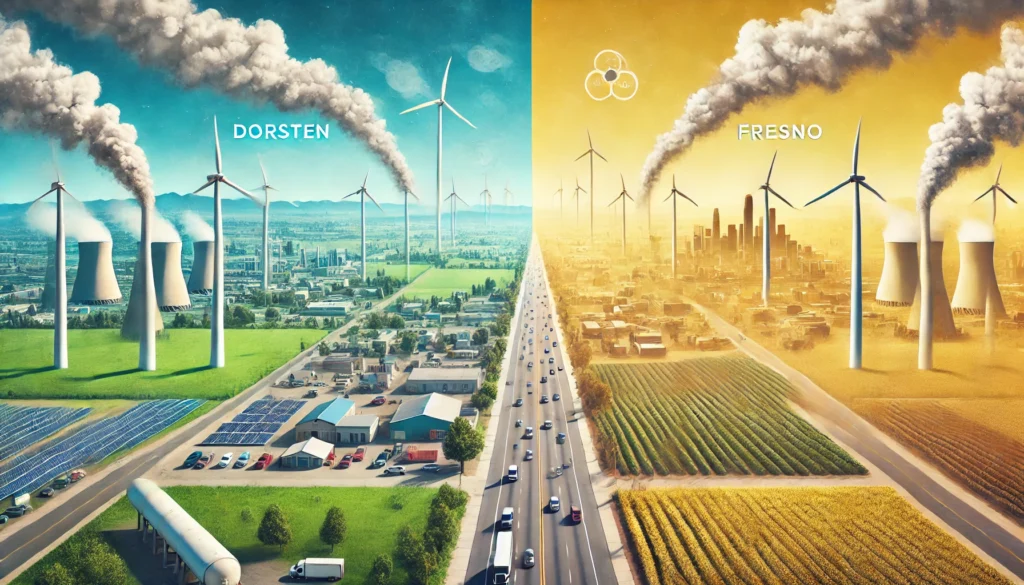Introduction
When it comes to the health of our environment, air quality plays a critical role. The growing awareness around pollution has led many to compare cities globally to better understand how geography, policy, and lifestyle affect the air we breathe. In this guide, we dive deep into Dorsten vs Fresno pollution, offering a unique perspective by evaluating key environmental and health indicators. Whether you’re a resident, traveler, or environmental enthusiast, this detailed comparison will help you understand which city offers cleaner air and a healthier environment.
Geographic and Demographic Context
Dorsten is a small city located in the North Rhine-Westphalia region of Germany. It features a temperate climate with moderate rainfall and lush greenery. With a population of around 75,000, it is more residential and less industrialized.
In contrast, Fresno, located in California’s Central Valley, has a much larger population exceeding 500,000. It is surrounded by agricultural land and experiences hot, dry summers and mild winters. The valley setting tends to trap pollutants, contributing to its well-known air quality issues.
These geographic and demographic differences are crucial in understanding the Dorsten vs Fresno pollution comparison, as location directly influences exposure to pollutants.
Understanding Air Quality Index (AQI)
The Air Quality Index (AQI) is a numerical scale used to communicate how clean or polluted the air is. It ranges from 0 to 500:
| AQI Range | Level of Health Concern | Color Code |
|---|---|---|
| 0–50 | Good | Green |
| 51–100 | Moderate | Yellow |
| 101–150 | Unhealthy for Sensitive Groups | Orange |
| 151–200 | Unhealthy | Red |
| 201–300 | Very Unhealthy | Purple |
| 301+ | Hazardous | Maroon |
The most common pollutants measured include PM2.5 (fine particles), PM10 (coarse particles), ozone (O3), nitrogen dioxide (NO2), and sulfur dioxide (SO2).
Current Pollution Data: Dorsten vs Fresno
Dorsten:
- Average AQI: 55–70 (Moderate)
- Primary pollutant: PM2.5
- Sources: Traffic emissions, residential heating, and some light industry
Fresno:
- Average AQI: 80–120 (Moderate to Unhealthy for Sensitive Groups)
- Primary pollutant: PM2.5 and ozone
- Sources: Vehicle emissions, agricultural burning, industrial pollution, and geography (air gets trapped in the valley)
Here’s a comparison table based on recent data:
| City | Average AQI | Main Pollutant | Health Concern Level |
|---|---|---|---|
| Dorsten | 60 | PM2.5 | Moderate |
| Fresno | 105 | PM2.5 & Ozone | Unhealthy for Sensitive Groups |
This direct comparison of Dorsten vs Fresno pollution highlights that while both cities experience pollution, Fresno’s levels are generally higher and more harmful to at-risk populations.
Seasonal Pollution Trends
Air quality isn’t static—it changes with the seasons. In Dorsten, winter brings an uptick in pollution due to increased use of heating systems. However, rainfall and wind help disperse pollutants.
Fresno sees the worst pollution during the summer and fall, especially when wildfires occur. Inversions in the Central Valley trap pollutants closer to the ground, worsening the situation. These patterns contribute to Fresno often ranking among the most polluted cities in the U.S.
Health Impacts of Air Pollution
Long-term exposure to air pollution is linked to numerous health problems including asthma, bronchitis, cardiovascular diseases, and even premature death.
- In Dorsten, moderate pollution may aggravate respiratory conditions in sensitive individuals, particularly children and the elderly.
- Fresno’s higher pollution levels pose a greater risk, especially to vulnerable groups. Hospitals often see increased respiratory cases during high AQI days.
The Dorsten vs Fresno pollution battle becomes more serious when viewed through a public health lens, especially considering the prolonged exposure of Fresno’s population to unhealthy air.
Environmental Policies and Initiatives
Germany enforces strict EU air quality regulations, and Dorsten benefits from these policies. There are low-emission zones, investments in public transport, and a national push toward renewable energy.
California also has some of the strictest air laws in the U.S., but enforcement can be inconsistent. Fresno’s agricultural industry complicates the picture, with emissions from machinery, fertilizers, and animal farms adding to pollution levels.
While both cities are making efforts, Dorsten appears to have more effective and widespread implementation of pollution control policies.
Urban Planning and Transportation
Dorsten encourages cycling and walking with pedestrian-friendly infrastructure. Public transit is reliable and widely used, reducing vehicular emissions.
Fresno’s urban sprawl and limited public transportation options make residents heavily reliant on personal vehicles. This increases emissions and worsens traffic-related air pollution.
Smart urban planning plays a key role in reducing pollution, and in this area, Dorsten is clearly ahead in the Dorsten vs Fresno pollution comparison.
Energy Sources and Industrial Influence
Dorsten is transitioning toward green energy, using solar, wind, and hydropower to reduce its carbon footprint. It also has fewer heavy industries.
Fresno is more industrial and agricultural, with power needs often met by fossil fuels. The burning of agricultural waste significantly contributes to particulate pollution.
This shows how a city’s economic foundation can influence its environmental profile.
Technological Tools and Citizen Awareness
Residents in both cities use apps and websites like IQAir and AirVisual to monitor real-time AQI. However, citizen participation in environmental advocacy is more visible in Germany due to strong grassroots movements and education systems that emphasize sustainability.
Scientific Research and Expert Insights
Studies by the WHO and EPA consistently rank Fresno among the most polluted urban areas in the U.S. In contrast, Dorsten doesn’t usually feature in such rankings, indicating relatively better air quality.
Experts suggest that sustainable urban design and consistent enforcement of environmental laws are key to Dorsten’s cleaner air.
Long-Term Outlook and Climate Change Impact
Climate change may worsen pollution through increased wildfires, longer pollen seasons, and heatwaves.
Dorsten’s climate policies and infrastructure upgrades may help mitigate future impacts. Fresno, however, may struggle more due to its vulnerable geographic location and heavy reliance on car-based infrastructure.
Which City Has Better Air Quality Overall?
Based on the data, Dorsten clearly has the edge when comparing Dorsten vs Fresno pollution. While neither city is completely free from pollution, Dorsten’s moderate AQI levels, proactive environmental policies, and sustainable lifestyle practices offer a cleaner, healthier atmosphere.
How to Protect Yourself from Air Pollution
- Check AQI daily using apps.
- Avoid outdoor activities during high pollution days.
- Use air purifiers indoors.
- Wear N95 masks when necessary.
- Support local clean air initiatives.
5 Unique FAQs About Dorsten vs Fresno Pollution
Q1: Is Dorsten considered a green city?
Yes, Dorsten has integrated green spaces, supports public transit, and encourages cycling, which contributes to its lower pollution levels.
Q2: How does agricultural activity in Fresno affect its air quality?
Fresno’s surrounding farms contribute to air pollution through pesticide use, dust, and machinery emissions, making it a significant factor.
Q3: Can visitors with asthma travel to Fresno safely?
Yes, but they should monitor AQI levels and avoid visiting during wildfire season or days with unhealthy AQI.
Q4: What technologies are used to measure air pollution in both cities?
Both cities use satellite data, ground-based sensors, and real-time AQI apps to monitor air quality effectively.
Q5: Are electric vehicles making a difference in Fresno?
Slowly, yes. EV adoption is growing, but fossil fuel use remains high compared to Dorsten, where eco-friendly transport is more common.
Conclusion
When comparing Dorsten vs Fresno pollution, it’s evident that Dorsten enjoys better air quality, thanks to proactive policies, efficient urban planning, and a commitment to sustainability. Fresno, while making efforts, still faces major challenges due to its geography, industrial activity, and car-centric infrastructure. Understanding these differences empowers residents and policymakers to make informed decisions for a cleaner, healthier future.
RECOMMENDED ARTICLES
How to Start # NixCoders.org Blog: A Step-by-Step Guide
Tonnosuke Uchi No Yome San Kakkokari: The Ultimate Guide & Analysis
eye_rene845: A Comprehensive Guide to Digital Eye Health
The Ultimate Guide to MarkNathan80: Biography, Career, Online Presence & Influence












